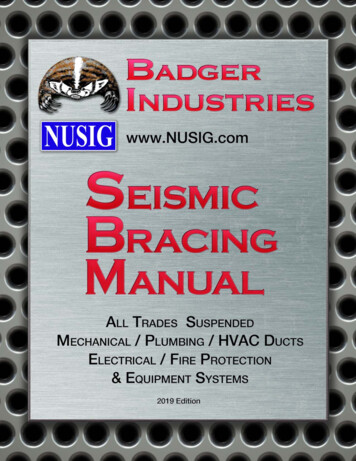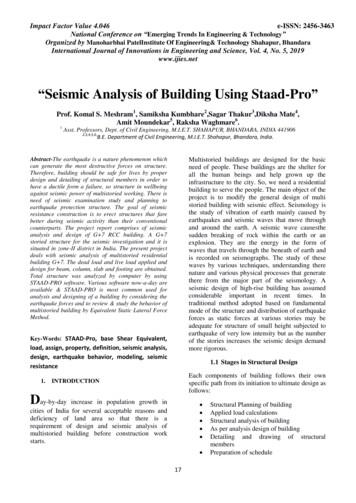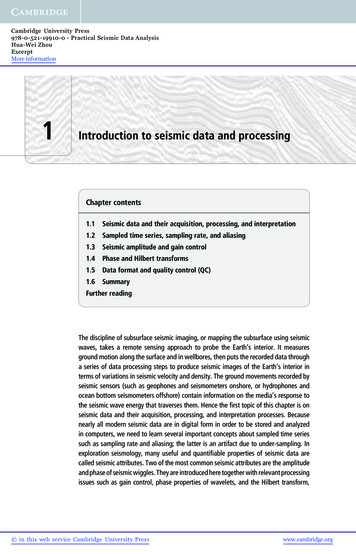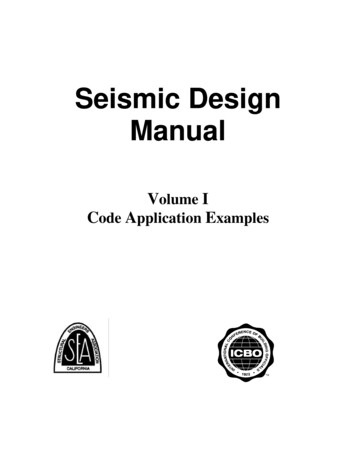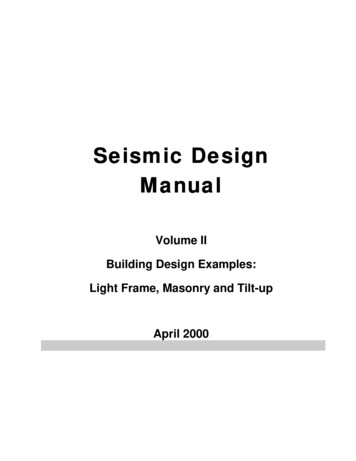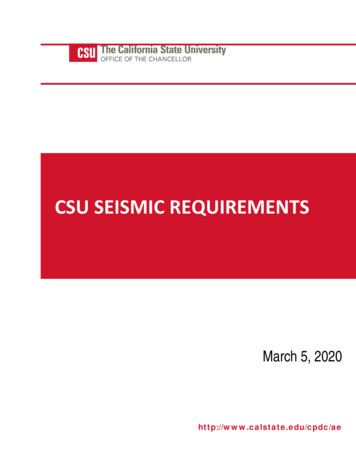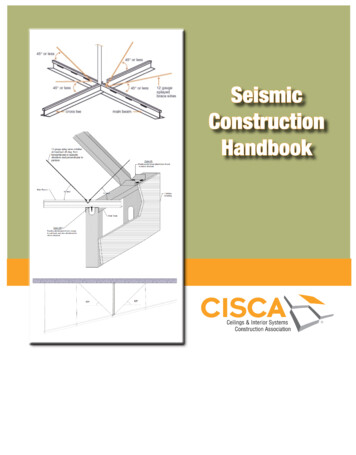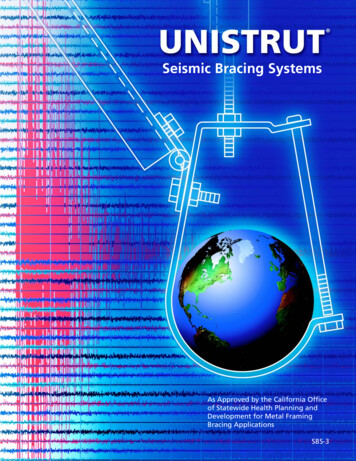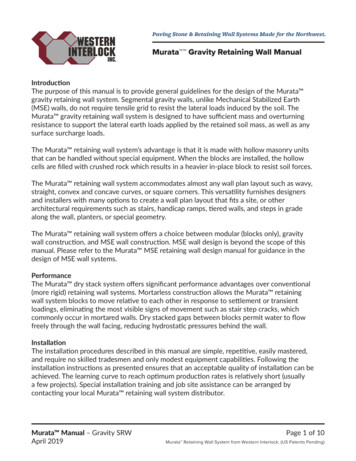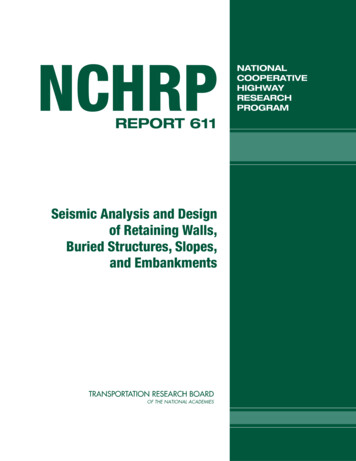
Transcription
NCHRPREPORT 611Seismic Analysis and Designof Retaining Walls,Buried Structures, Slopes,and AM
TRANSPORTATION RESEARCH BOARD 2008 EXECUTIVE COMMITTEE*OFFICERSCHAIR: Debra L. Miller, Secretary, Kansas DOT, TopekaVICE CHAIR: Adib K. Kanafani, Cahill Professor of Civil Engineering, University of California, BerkeleyEXECUTIVE DIRECTOR: Robert E. Skinner, Jr., Transportation Research BoardMEMBERSJ. Barry Barker, Executive Director, Transit Authority of River City, Louisville, KYAllen D. Biehler, Secretary, Pennsylvania DOT, HarrisburgJohn D. Bowe, President, Americas Region, APL Limited, Oakland, CALarry L. Brown, Sr., Executive Director, Mississippi DOT, JacksonDeborah H. Butler, Executive Vice President, Planning, and CIO, Norfolk Southern Corporation, Norfolk, VAWilliam A.V. Clark, Professor, Department of Geography, University of California, Los AngelesDavid S. Ekern, Commissioner, Virginia DOT, RichmondNicholas J. Garber, Henry L. Kinnier Professor, Department of Civil Engineering, University of Virginia, CharlottesvilleJeffrey W. Hamiel, Executive Director, Metropolitan Airports Commission, Minneapolis, MNEdward A. (Ned) Helme, President, Center for Clean Air Policy, Washington, DCWill Kempton, Director, California DOT, SacramentoSusan Martinovich, Director, Nevada DOT, Carson CityMichael D. Meyer, Professor, School of Civil and Environmental Engineering, Georgia Institute of Technology, AtlantaMichael R. Morris, Director of Transportation, North Central Texas Council of Governments, ArlingtonNeil J. Pedersen, Administrator, Maryland State Highway Administration, BaltimorePete K. Rahn, Director, Missouri DOT, Jefferson CitySandra Rosenbloom, Professor of Planning, University of Arizona, TucsonTracy L. Rosser, Vice President, Corporate Traffic, Wal-Mart Stores, Inc., Bentonville, ARRosa Clausell Rountree, Executive Director, Georgia State Road and Tollway Authority, AtlantaHenry G. (Gerry) Schwartz, Jr., Chairman (retired), Jacobs/Sverdrup Civil, Inc., St. Louis, MOC. Michael Walton, Ernest H. Cockrell Centennial Chair in Engineering, University of Texas, AustinLinda S. Watson, CEO, LYNX–Central Florida Regional Transportation Authority, OrlandoSteve Williams, Chairman and CEO, Maverick Transportation, Inc., Little Rock, AREX OFFICIO MEMBERSThad Allen (Adm., U.S. Coast Guard), Commandant, U.S. Coast Guard, Washington, DCJoseph H. Boardman, Federal Railroad Administrator, U.S.DOTRebecca M. Brewster, President and COO, American Transportation Research Institute, Smyrna, GAPaul R. Brubaker, Research and Innovative Technology Administrator, U.S.DOTGeorge Bugliarello, President Emeritus and University Professor, Polytechnic Institute of New York University, Brooklyn; Foreign Secretary,National Academy of Engineering, Washington, DCSean T. Connaughton, Maritime Administrator, U.S.DOTLeRoy Gishi, Chief, Division of Transportation, Bureau of Indian Affairs, U.S. Department of the Interior, Washington, DCEdward R. Hamberger, President and CEO, Association of American Railroads, Washington, DCJohn H. Hill, Federal Motor Carrier Safety Administrator, U.S.DOTJohn C. Horsley, Executive Director, American Association of State Highway and Transportation Officials, Washington, DCCarl T. Johnson, Pipeline and Hazardous Materials Safety Administrator, U.S.DOTJ. Edward Johnson, Director, Applied Science Directorate, National Aeronautics and Space Administration, John C. Stennis Space Center, MSDavid Kelly, Acting Administrator, National Highway Traffic Safety Administration, U.S.DOTThomas J. Madison, Jr., Administrator, Federal Highway Administration, U.S.DOTWilliam W. Millar, President, American Public Transportation Association, Washington, DCJames S. Simpson, Federal Transit Administrator, U.S.DOTRobert A. Sturgell, Acting Administrator, Federal Aviation Administration, U.S.DOTRobert L. Van Antwerp (Lt. Gen., U.S. Army), Chief of Engineers and Commanding General, U.S. Army Corps of Engineers, Washington, DC*Membership as of November 2008.
NATIONAL COOPERATIVE HIGHWAY RESEARCH PROGRAMNCHRP REPORT 611Seismic Analysis and Designof Retaining Walls,Buried Structures, Slopes,and EmbankmentsDonald G. AndersonCH2M HILLBellevue, WAGeoffrey R. MartinUNIVERSITY OF SOUTHERN CALIFORNIALos Angeles, CAIgnatius (Po) LamEARTH MECHANICS, INC.Fountain Valley, CAJ. N. (Joe) WangPARSONS BRINCKERHOFF INC.New York, NYSubject AreasBridges, Other Structures, and Hydraulics and HydrologyResearch sponsored by the American Association of State Highway and Transportation Officialsin cooperation with the Federal Highway AdministrationTRANSPORTATION RESEARCH BOARDWASHINGTON, D.C.2008www.TRB.org
NATIONAL COOPERATIVE HIGHWAYRESEARCH PROGRAMNCHRP REPORT 611Systematic, well-designed research provides the most effectiveapproach to the solution of many problems facing highwayadministrators and engineers. Often, highway problems are of localinterest and can best be studied by highway departments individuallyor in cooperation with their state universities and others. However, theaccelerating growth of highway transportation develops increasinglycomplex problems of wide interest to highway authorities. Theseproblems are best studied through a coordinated program ofcooperative research.In recognition of these needs, the highway administrators of theAmerican Association of State Highway and Transportation Officialsinitiated in 1962 an objective national highway research programemploying modern scientific techniques. This program is supported ona continuing basis by funds from participating member states of theAssociation and it receives the full cooperation and support of theFederal Highway Administration, United States Department ofTransportation.The Transportation Research Board of the National Academies wasrequested by the Association to administer the research programbecause of the Board’s recognized objectivity and understanding ofmodern research practices. The Board is uniquely suited for thispurpose as it maintains an extensive committee structure from whichauthorities on any highway transportation subject may be drawn; itpossesses avenues of communications and cooperation with federal,state and local governmental agencies, universities, and industry; itsrelationship to the National Research Council is an insurance ofobjectivity; it maintains a full-time research correlation staff ofspecialists in highway transportation matters to bring the findings ofresearch directly to those who are in a position to use them.The program is developed on the basis of research needs identifiedby chief administrators of the highway and transportation departmentsand by committees of AASHTO. Each year, specific areas of researchneeds to be included in the program are proposed to the NationalResearch Council and the Board by the American Association of StateHighway and Transportation Officials. Research projects to fulfill theseneeds are defined by the Board, and qualified research agencies areselected from those that have submitted proposals. Administration andsurveillance of research contracts are the responsibilities of the NationalResearch Council and the Transportation Research Board.The needs for highway research are many, and the NationalCooperative Highway Research Program can make significantcontributions to the solution of highway transportation problems ofmutual concern to many responsible groups. The program, however, isintended to complement rather than to substitute for or duplicate otherhighway research programs.Project 12-70ISSN 0077-5614ISBN: 978-0-309-11765-4Library of Congress Control Number 2008911003 2008 Transportation Research BoardCOPYRIGHT PERMISSIONAuthors herein are responsible for the authenticity of their materials and for obtainingwritten permissions from publishers or persons who own the copyright to any previouslypublished or copyrighted material used herein.Cooperative Research Programs (CRP) grants permission to reproduce material in thispublication for classroom and not-for-profit purposes. Permission is given with theunderstanding that none of the material will be used to imply TRB, AASHTO, FAA, FHWA,FMCSA, FTA, or Transit Development Corporation endorsement of a particular product,method, or practice. It is expected that those reproducing the material in this document foreducational and not-for-profit uses will give appropriate acknowledgment of the source ofany reprinted or reproduced material. For other uses of the material, request permissionfrom CRP.NOTICEThe project that is the subject of this report was a part of the National Cooperative HighwayResearch Program conducted by the Transportation Research Board with the approval ofthe Governing Board of the National Research Council. Such approval reflects theGoverning Board’s judgment that the program concerned is of national importance andappropriate with respect to both the purposes and resources of the National ResearchCouncil.The members of the technical committee selected to monitor this project and to review thisreport were chosen for recognized scholarly competence and with due consideration for thebalance of disciplines appropriate to the project. The opinions and conclusions expressedor implied are those of the research agency that performed the research, and, while they havebeen accepted as appropriate by the technical committee, they are not necessarily those ofthe Transportation Research Board, the National Research Council, the AmericanAssociation of State Highway and Transportation Officials, or the Federal HighwayAdministration, U.S. Department of Transportation.Each report is reviewed and accepted for publication by the technical committee accordingto procedures established and monitored by the Transportation Research Board ExecutiveCommittee and the Governing Board of the National Research Council.The Transportation Research Board of the National Academies, the National ResearchCouncil, the Federal Highway Administration, the American Association of State Highwayand Transportation Officials, and the individual states participating in the NationalCooperative Highway Research Program do not endorse products or manufacturers. Tradeor manufacturers’ names appear herein solely because they are considered essential to theobject of this report.Published reports of theNATIONAL COOPERATIVE HIGHWAY RESEARCH PROGRAMare available from:Transportation Research BoardBusiness Office500 Fifth Street, NWWashington, DC 20001and can be ordered through the Internet Printed in the United States of America
COOPERATIVE RESEARCH PROGRAMSCRP STAFF FOR NCHRP REPORT 611Christopher W. Jenks, Director, Cooperative Research ProgramsCrawford F. Jencks, Deputy Director, Cooperative Research ProgramsDavid B. Beal, Senior Program OfficerEileen P. Delaney, Director of PublicationsMargaret B. Hagood, EditorNCHRP PROJECT 12-70 PANELField of Design—Area of BridgesHarry A. Capers, Jr., Arora and Associates, P.C., Lawrenceville, NJ (Chair)Darrin Beckett, Kentucky Transportation Cabinet, Frankfort, KYDonald Dwyer, New York State DOT, Albany, NYIan M. Friedland, Federal Highway Administration, McLean, VAMichael G. Katona, Gig Harbor, WAScott M. Olson, University of Illinois–Urbana-Champaign, Urbana, ILM. “Saiid” Saiidi, University of Nevada–Reno, Reno, NVAnoosh Shamsabadi, California DOT, Irvine, CAMunindra Talukdar, Washington State DOT, Tumwater, WAJerry A. DiMaggio, FHWA LiaisonG. P. Jayaprakash, TRB LiaisonAUTHOR ACKNOWLEDGMENTSWork for the NCHRP 12-70 Project was carried out by a Project Team led by CH2M HILL of Bellevue,Washington, with major support from Earth Mechanics, Inc. of Fountain Valley, California and ParsonsBrinckerhoff Inc. of New York City, New York. Leadership for the Project Team was provided by the following individuals: Dr. Donald Anderson, P.E. from CH2M HILL in Bellevue, Washington, who was theproject manager for the work; Professor Geoffrey R. Martin, P.E. from the University of Southern California, who served as a Principal Investigator; Mr. Ignatius (Po) Lam, P.E. from Earth Mechanics, whoserved as another Principal Investigator; and Dr. J.N. (Joe) Wang, P.E. from Parsons Brinckerhoff, whoalso served as a principal investigator.The Project included a Technical Advisory Panel that provided technical input to the Project at variouspoints during the project duration. The panel members included: Professor Robert Holtz, P.E. from theUniversity of Washington; Dr. Lee Marsh, P.E. from Berger ABAM in Federal Way, Washington; Professor Edward Kavazanjian, P.E. from Arizona State University; and Professor Tom O’Rourke, P.E. from Cornell UniversityA number of other individuals provided important input to the project, including Mr. Tony Allen, P.E.,Chief Geotechnical Engineer with the Washington State Department of Transportation, and Dr. AnooshShamsabadi, P.E, structural research engineer with the California Department of Transportation (Caltrans). The practical feedback from both individuals was particularly helpful. Mr. Amir Zand and Dr.Hubert Law from Earth Mechanics also provided major support by conducting analyses and assisting withthe development of example problems.
FOREWORDBy David B. BealStaff OfficerTransportation Research BoardThis report provides analytical and design methods for the seismic design of retainingwalls, buried structures, slopes, and embankments. The report details the development ofthe design procedures. Recommended LRFD specifications and design examples illustrating the application of the design methods and specifications are included in an Appendix.The material in this report will be of immediate interest to roadway and bridge designers.A comprehensive load and resistance factor design (LRFD) specification for the seismicdesign of highway bridges has been developed by AASHTO. Those specifications reflect thelatest bridge design philosophies for achieving high levels of seismic performance. Becausethese specifications are limited to highway bridges and components that are directly attached to them, such as abutments and wing walls, they do not address new or improvedanalytical methods or seismic design provisions for retaining walls, buried structures,slopes, or embankments.The objective of NCHRP Project 12-70 was to remove the limitations of the current specifications through the development of analytical and design methods for the seismic designof retaining walls, buried structures, slopes, and embankments. This research was managedby Donald Anderson, CH2M HILL, Bellevue, Washington, with the assistance of GeoffreyMartin, University of Southern California; Po Lam, Earth Mechanics; and Joe Wang,Parson Brinckerhoff, New York. The report fully documents the program used to developthe design procedures.The Final Report is organized into two volumes. Volume 1 is published here as NCHRPReport 611. Volume 2 is available at the TRB website at http://trb.org/news/blurb detail.asp?id 9631.
CONTENTSVOLUME 1Final Report1 Chapter 1 3242526262828293030313133331.1 Overall Project Objectives, Approach, and Schedule1.2 Project Background1.2.1 Plans for Implementing the LRFD Design Methodology1.2.2 Overview of Conclusions from Initial Phase of Work1.2.3 Overview of Conclusions from Second Phase of Work1.2.4 Overview of Conclusions from Third Phase of Work1.3 Organization of Final Report1.3.1 Volume 1—Final Project Report1.3.2 Volume 2—Recommended Specifications, Commentaries,and Example ProblemsChapter 2 Data Collection and Review2.1 Earthquake Design Basis2.2 Literature Search2.2.1 Key References2.2.2 General Observations2.3 DOT, Vendor, and Consultant Contacts2.4 ConclusionsChapter 3 Problems and Knowledge Gaps3.1 Retaining Walls3.1.1 Gravity and Semi-Gravity Walls3.1.2 MSE Retaining Walls3.1.3 Soil Nail Walls3.2 Slopes and Embankments3.2.1 Seismic Considerations for Soil Slopes3.2.2 Seismic Considerations for Rock Slopes3.3 Buried Structures3.4 ConclusionsChapter 4 Work Plan: Analytical Methodologies4.1 Developments for Seismic Ground Motions4.2 Developments for Retaining Walls4.2.1 Generalized Limit Equilibrium Analyses4.2.2 Wall Height-Dependent Seismic Coefficient4.2.3 Deformation Analyses4.3 Developments for Slopes and Embankments4.4 Developments for Buried Structures4.4.1 Analysis Procedures for TGD4.4.2 Analysis Procedures for Permanent Ground Deformations (PGD)4.5 Summary
r 5 Seismic Ground Motions5.1 Seismic Loading Criteria5.1.1 Update to AASHTO Seismic Ground Motion Criteria5.1.2 Range of Ground Shaking Levels in the United Statesfor Referenced Soft Rock5.1.3 Variation in Spectral Shapes for Soil and Rock Sitesin WUS versus CEUS5.2 Newmark Displacement Correlations5.2.1 Approach for Updating Newmark Charts5.2.2 Description of Ground Motion Database5.2.3 Permanent Displacement Data5.2.4 Microsoft Access Database5.2.5 Spectral Acceleration Characteristics5.2.6 Correlation between PGV and S1, PGA and M5.2.7 Newmark Sliding Block Displacement Correlations5.2.8 Comparison Between Correlations5.2.9 Confidence Level5.2.10 Design Recommendations5.3 Correlation of PGV with S15.4 ConclusionsChapter 6 Height-Dependent Seismic Coefficients6.1 Wave Scattering Evaluations6.1.1 Scattering Analyses for a Slope6.1.2 Scattering Analyses for Retaining Walls6.2 ConclusionsChapter 7 Retaining Walls7.1 Current Design Practice7.2 The M-O Method and Limitations7.2.1 Seismic Active Earth Pressures7.2.2 Seismic Passive Earth Pressures7.3 M-O Earth Pressures for Cohesive Soils7.3.1 Evaluation of the Contribution from Cohesion7.3.2 Results of M-O Analyses for Soils with Cohesion7.3.3 Implication to Design7.4 GLE Approach for Determining Seismic Active Pressures7.5 Height-Dependent Seismic Design Coefficients7.5.1 Evaluation of Impedance Contrasts and Soil Behavior7.5.2 Results of Impedance Contrast and Nonlinearity Evaluations7.6 Displacement-Based Design for Gravity, Semi Gravity, and MSE Walls7.7 Conventional Gravity and Semi-Gravity Walls—RecommendedDesign Method for External Stability7.8 MSE Walls—Recommended Design Methods7.8.1 Current Design Methodology7.8.2 MSE Walls—Design Method for External Stability7.8.3 MSE Walls—Design Method for Internal Stability7.9 Other Wall Types7.9.1 Nongravity Cantilevered Walls7.9.2 Anchored Walls7.9.3 Soil Nail Walls7.10 Conclusions
1131132133133Chapter 8 Slopes and Embankments8.1 Types and Performance of Slopes8.1.1 Engineered Slopes and Embankments8.1.2 Natural Slopes8.2 Current Practice8.2.1 Limit Equilibrium Approach8.2.2 Displacement-Based Approach8.3 Proposed Design Methodology8.3.1 Limit Equilibrium Approach8.3.2 Displacement-Based Approach8.4 Example Application8.4.1 Problem Description8.4.2 Results8.5 Other Considerations8.5.1 Limit Equilibrium Design Methods8.5.2 No Analysis Cut-off8.5.3 Liquefaction Potential8.6 ConclusionsChapter 9 Buried Structures9.1 Seismic Performance of Culverts and Pipelines9.2 Culvert/Pipe Characteristics9.2.1 Flexible Culverts and Pipes9.2.2 Rigid Culverts and Pipes9.3 General Effects of Earthquakes and Potential Failure Modes9.3.1 Ground Shaking9.3.2 Ground Failure9.4 Current Seismic Design Practice for Culverts or Other Buried Structures9.5 General Methodology and Recommended Procedures9.5.1 Ovaling of Circular Conduits9.5.2 Racking of Rectangular Conduits9.6 Parametric and Verification Analysis9.6.1 Types of Structures and Other Parameters Used in Evaluation9.6.2 Model Assumptions and Results9.7 Conclusions and RecommendationsChapter 10 Recommendations for Future Work10.110.210.310.410.5Ground Motions and DisplacementsRetaining WallsSlopes and EmbankmentsBuried StructuresNeed for Confirming Methods134References137Appendices
1CHAPTER 1IntroductionThis Final Report summarizes work that was carried out onNational Cooperative Highway Research Program (NCHRP)Project 12-70 Seismic Analysis and Design of Retaining Walls,Buried Structures, Slopes, and Embankments. This project involved an effort to develop analysis and design methods andrecommended load and resistance factor design (LRFD) specifications for the seismic design of retaining walls, slopes andembankments, and buried structures. Optimizing design approaches for both routine design and1.1 Overall Project Objectives,Approach, and ScheduleThe approach for the Project initially focused on data collection and review during Task 1, leading to the documentationof problems and knowledge gaps in Task 2. The problems andknowledge gaps identified in Task 2 were used to recommendanalytical methodology developments in Task 3, and a detailedwork plan in Task 4. The results of these four tasks weresummarized in Task 5, the first Interim Report. This phase ofthe work occurred within the first 9 months of the planned39-month project duration.Following submittal of the first Interim Report and theNCHRP Oversight Panel’s review and approval of the workplan described in the first Interim Report, the approved workplan was implemented in Task 6. An outline of the LRFDspecifications was prepared in Task 7, and the results of theanalytical developments and LRFD specification outline weresummarized in Task 8, which was identified as the second Interim Report. The submittal of the second Interim Reportconcluded Phase 1 of the Project. The schedule for completing the second Interim Report was originally planned to beapproximately 22 months after the initiation of the Project;however, actual work took approximately 24 months.Phase 2 was initiated upon completion of Task 8. Thisphase involved Task Orders 9-12, where specifications, commentaries, and example problems were prepared and submitted to the NCHRP Oversight Panel for review. The thirdInterim Report provided the first draft of the specifications,commentaries, and example problems, in accordance withthe requirements of Task 10. Following receipt of commentsThe overall objectives of the Project were to develop analysisand design methods and to prepare LRFD specifications and example problems for the design of retaining walls, slopes and embankments, and buried structures. These overall objectives wereintended to address short-comings in AASHTO LRFD BridgeDesign Specifications or in some cases the absence of a recommended design methodology in the LRFD Specifications.The approach used to address these two objectives was outlined in a Working Plan submitted by the Project Team toNCHRP in May of 2004. The Working Plan is based on CH2MHILL’s proposal to NCHRP in November of 2003, with modifications summarized in Attachment 2 of CH2M HILL’s letterdated January 13, 2004, to Dr. Robert Reilly of the Transportation Research Board. Also included in this Working Plan wasa Progress Schedule tied to the Project start date of March 29,2004, and a Table of Deliverables for this Project. A copy ofthe Working Plan for the Project is included in Appendix Ato Volume 1 of this Final Report.Five fundamental goals were identified during the planning of the Project in 2004. These goals formed the basis forthe work that was to be done during each Project activity. Thefive goals involved Improving existing or developing new analytical methodsto overcome the shortcomings of existing technology,based on sound soil-structure interaction principles;special design cases using more comprehensive methods; Avoiding hidden conservatism in design approaches; Ensuring applicability of specifications to seismic zonesnationwide, including provisions for “no seismic design”in low seismicity regions; and Satisfying LRFD philosophy and providing flexibility inestablishing serviceability criteria.
2from the NCHRP Oversight Panel, Task 11 was implemented.This task involved (1) making further modifications to thespecifications, commentaries, and example problems; (2) addressing the Oversight Panel’s comments on the third InterimReport, and (3) and preparing a Final Report. This work wasscheduled to be completed after 35 months but took approximately 39 months.The final work activity in Phase 2 on the Project, Task 12,involved preparation of this Final Report and the revised specifications, commentaries, and example problems. This taskwas finalized in November of 2007, approximately 44 monthsfollowing initiation of the Working Plan in April of 2004. Following this submittal, an additional example problem wascompleted, specifications and commentaries were revised,and the Final Report finalized in June 2008.Throughout work on each task within the Project there wasa continuing effort to focus on the final product of the Project.This product involved a methodology that could be used inareas that are both highly seismic and relatively aseismic; thatcould be implemented by staff from DOTs, vendors, and consulting firms using existing software without the need for extensive training; and that “made sense” relative to observedperformance during past earthquakes. This theme was implemented throughout the Project, from start to finish. To theextent practical, this theme is followed in the presentation ofeach chapter of this Draft Final Report.1.2 Project BackgroundWork on the NCHRP 12-70 Project was initiated in Aprilof 2004. The following three subsections provide backgroundinformation for the work that has been accomplished. Thisbackground information includes a summary of plans forimplementing the overall LRFD design methodology andoverviews of interim conclusions from the work performedon the Project. The overview of conclusions helps provide aperspective for the development work that is being summarizedin subsequent chapters.1.2.1 Plans for Implementingthe LRFD Design MethodologyThe work carried out for the NCHRP 12-70 Project must beconsistent with the philosophy and format of the AASHTOLRFD Bridge Design Specifications and the seismic provisionsfor highway bridges. In this philosophy, “Bridges shall be designed for specified limit states to achieve the objectives ofconstructibility, safety, and serviceability, with due regard toissues of inspectibility, economy, and aesthetics. . . .” In theLRFD procedure, margins of safety are incorporated throughload (γp) factors and performance (or resistance, φr) factors.1.2.1.1 Factors to ConsiderThe basic requirement for this Project is to ensure that factored capacity exceeds factored load as defined by the followingequation for various limit states (or acceptable performance):φ r Rn Σγ pi Qi(1-1)whereφr performance factor;Rn nominal resistance;γpi load factor for load component I; andQi load effect due to load component i.During the initial phase of work for this Project, the LRFDmethodology was not formerly introduced. Rather, the focusof the work was on the identification and evaluation of a design methodology without load or resistance factors. Once themethodologies were developed and approved, then an approachfor incorporating load and resistance factors was establishedrelative to the recommended methodologies.Although work on the initial phase of work did not presentrecommendations on load and resistance factors to use withthe proposed methodologies, consideration was given by theProject Team to how load and resistance factors might eventually be used during seismic design. Ideally this approach wouldbuild on the load and resistance factors used in the conventional static load case presented in the current version of theAASHTO LRFD Bridge Design Specifications.For the static design case the appropriate load and resistance factors have been developed to yield a consistent marginof safety in the designed structure. This same logic needs tobe followed for seismic loading to retaining walls, slopes andembankments, and buried structures. However, the approachfor defining a consistent margin of safety is more difficult todefine for the following reasons: The load factors and load cases (that is, on the right-hand-side of the above equation) had to be consistent withthose recommended by the NCHRP Project 20-07 Recommended LRFD Guidelines for the Seismic Design of HighwayBridges (Imbsen, 2006). At the time the NCHRP 12-70 Project was initiated, the NCHRP 20-07 Project was establishingthe appropriate earthquake loading return period—subjectto the approval of the AASHTO Highway Subcommitteeon Bridges and Structures (HSCOBS T-3) and eventuallythe AASHTO voting members. These recommendationswould result in larger loads associated with a seismic eventat a specific site relative to the then current AASHTO requirements, but the likelihood of the load occurring decreased and would be relatively infrequent. Under this situation use of a load factor on the seismic load was believedto be overly conservative. (The NCHRP 20-07 Project wasoriginally referred to as the NCHRP 12-49 Update Project.
3The intent of the NCHRP 12-07 Project was to revise recommendations given in the NCHRP 12-49 Project (NCHRPReport 472, 2003) for use in updating seismic provisions inthe AASHTO LRFD Bridge Design Specifications. One of thekey recommendations initially made by the NCHRP 20-07Project was to increase the return period for seismic designfrom the 500-year level in the then current (2006) LRFDspecifications to a 1,000-year return period. The probabilityof occurrence for the 1,000-year event is approximately7 percent in 75 years. This recommendation was approved byAASHTO in July of 2007, at the time that the NCHRP 12-70Project report was being finalized.) From a resistance factor standpoint, design could be performed using either a limit equilibrium or displacementbased approach. The selection of resistance factors for thesetwo cases will differ. For example, use of a resistance factorless than 1.0 often will result in a conservative design usinglimit equilibrium methods,
May 02, 2010 · This report provides analytical and design methods for the seismic design of retaining walls, buried structures, slopes, and embankments. The report details the development of the design procedures. Recommended LRFD specifications and design examples illustrat-ing the application of the design

